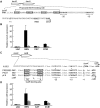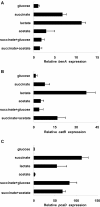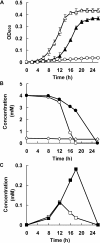Genome-wide investigation and functional characterization of the beta-ketoadipate pathway in the nitrogen-fixing and root-associated bacterium Pseudomonas stutzeri A1501
- PMID: 20137101
- PMCID: PMC2907835
- DOI: 10.1186/1471-2180-10-36
Genome-wide investigation and functional characterization of the beta-ketoadipate pathway in the nitrogen-fixing and root-associated bacterium Pseudomonas stutzeri A1501
Abstract
Background: Soil microorganisms are mainly responsible for the complete mineralization of aromatic compounds that usually originate from plant products or environmental pollutants. In many cases, structurally diverse aromatic compounds can be converted to a small number of structurally simpler intermediates, which are metabolized to tricarboxylic acid intermediates via the beta-ketoadipate pathway. This strategy provides great metabolic flexibility and contributes to increased adaptation of bacteria to their environment. However, little is known about the evolution and regulation of the beta-ketoadipate pathway in root-associated diazotrophs.
Results: In this report, we performed a genome-wide analysis of the benzoate and 4-hydroxybenzoate catabolic pathways of Pseudomonas stutzeri A1501, with a focus on the functional characterization of the beta-ketoadipate pathway. The P. stutzeri A1501 genome contains sets of catabolic genes involved in the peripheral pathways for catabolism of benzoate (ben) and 4-hydroxybenzoate (pob), and in the catechol (cat) and protocatechuate (pca) branches of the beta-ketoadipate pathway. A particular feature of the catabolic gene organization in A1501 is the absence of the catR and pcaK genes encoding a LysR family regulator and 4-hydroxybenzoate permease, respectively. Furthermore, the BenR protein functions as a transcriptional activator of the ben operon, while transcription from the catBC promoter can be activated in response to benzoate. Benzoate degradation is subject to carbon catabolite repression induced by glucose and acetate in A1501. The HPLC analysis of intracellular metabolites indicated that low concentrations of 4-hydroxybenzoate significantly enhance the ability of A1501 to degrade benzoate.
Conclusions: The expression of genes encoding proteins involved in the beta-ketoadipate pathway is tightly modulated by both pathway-specific and catabolite repression controls in A1501. This strain provides an ideal model system for further study of the evolution and regulation of aromatic catabolic pathways.
Figures








Similar articles
-
Repression of 4-hydroxybenzoate transport and degradation by benzoate: a new layer of regulatory control in the Pseudomonas putida beta-ketoadipate pathway.J Bacteriol. 1995 Dec;177(24):7033-40. doi: 10.1128/jb.177.24.7033-7040.1995. J Bacteriol. 1995. PMID: 8522507 Free PMC article.
-
The target for the Pseudomonas putida Crc global regulator in the benzoate degradation pathway is the BenR transcriptional regulator.J Bacteriol. 2008 Mar;190(5):1539-45. doi: 10.1128/JB.01604-07. Epub 2007 Dec 21. J Bacteriol. 2008. PMID: 18156252 Free PMC article.
-
BenR, a XylS homologue, regulates three different pathways of aromatic acid degradation in Pseudomonas putida.J Bacteriol. 2000 Nov;182(22):6339-46. doi: 10.1128/JB.182.22.6339-6346.2000. J Bacteriol. 2000. PMID: 11053377 Free PMC article.
-
The beta-ketoadipate pathway and the biology of self-identity.Annu Rev Microbiol. 1996;50:553-90. doi: 10.1146/annurev.micro.50.1.553. Annu Rev Microbiol. 1996. PMID: 8905091 Review.
-
Transcriptional activation of the catechol and chlorocatechol operons: variations on a theme.Gene. 1998 Nov 26;223(1-2):257-67. doi: 10.1016/s0378-1119(98)00366-7. Gene. 1998. PMID: 9858745 Review.
Cited by
-
Study of PcaV from Streptomyces coelicolor yields new insights into ligand-responsive MarR family transcription factors.Nucleic Acids Res. 2013 Apr 1;41(6):3888-900. doi: 10.1093/nar/gkt009. Epub 2013 Feb 8. Nucleic Acids Res. 2013. PMID: 23396446 Free PMC article.
-
Comparative genomic analysis of four representative plant growth-promoting rhizobacteria in Pseudomonas.BMC Genomics. 2013 Apr 22;14:271. doi: 10.1186/1471-2164-14-271. BMC Genomics. 2013. PMID: 23607266 Free PMC article.
-
Mapping the diversity of microbial lignin catabolism: experiences from the eLignin database.Appl Microbiol Biotechnol. 2019 May;103(10):3979-4002. doi: 10.1007/s00253-019-09692-4. Epub 2019 Apr 8. Appl Microbiol Biotechnol. 2019. PMID: 30963208 Free PMC article. Review.
-
New Findings on Aromatic Compounds' Degradation and Their Metabolic Pathways, the Biosurfactant Production and Motility of the Halophilic Bacterium Halomonas sp. KHS3.Curr Microbiol. 2018 Aug;75(8):1108-1118. doi: 10.1007/s00284-018-1497-x. Epub 2018 Apr 24. Curr Microbiol. 2018. PMID: 29693197
-
Metabolic and Evolutionary Insights in the Transformation of Diphenylamine by a Pseudomonas putida Strain Unravelled by Genomic, Proteomic, and Transcription Analysis.Front Microbiol. 2018 Apr 6;9:676. doi: 10.3389/fmicb.2018.00676. eCollection 2018. Front Microbiol. 2018. PMID: 29681895 Free PMC article.
References
-
- Barbe V, Vallenet D, Fonknechten N, Kreimeyer A, Oztas S, Labarre L, Cruveiller S, Robert C, Duprat S, Wincker P, Ornston LN, Weissenbach J, Marlière P, Cohen GN, Médigue C. Unique features revealed by the genome sequence of Acinetobacter sp. ADP1, a versatile and naturally transformation competent bacterium. Nucleic Acids Res. 2004;32(19):5766–5779. doi: 10.1093/nar/gkh910. - DOI - PMC - PubMed
Publication types
MeSH terms
Substances
LinkOut - more resources
Full Text Sources
Other Literature Sources
Miscellaneous

